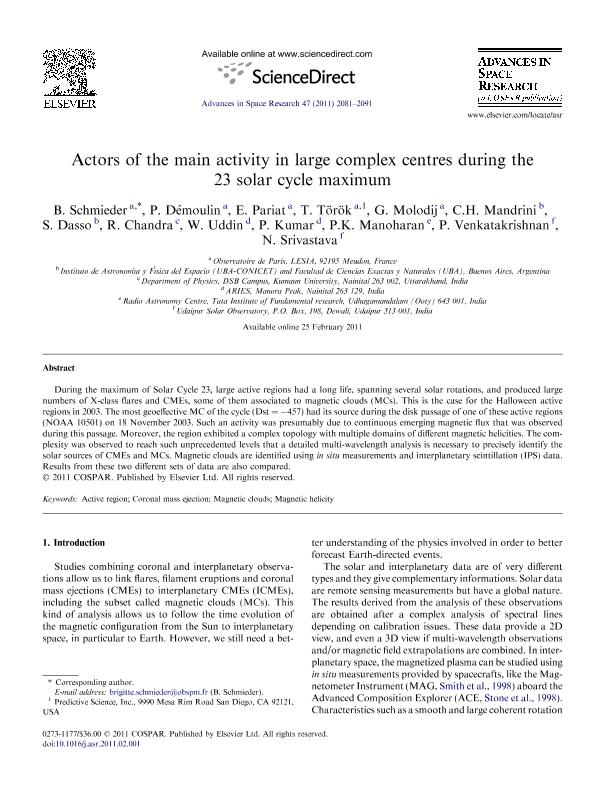Artículo
Actors of the main activity in large complex centres during the 23 solar cycle maximum
Schmieder, B.; Démoulin, Pascal; Pariat, E.; Török, T.; Molodij, G.; Mandrini, Cristina Hemilse ; Dasso, Sergio Ricardo
; Dasso, Sergio Ricardo ; Chandra, R.; Uddin, W.; Kumar, P.; Manoharan, P.K.; Venkatakrishnan, P.; Srivastava, N.
; Chandra, R.; Uddin, W.; Kumar, P.; Manoharan, P.K.; Venkatakrishnan, P.; Srivastava, N.
 ; Dasso, Sergio Ricardo
; Dasso, Sergio Ricardo ; Chandra, R.; Uddin, W.; Kumar, P.; Manoharan, P.K.; Venkatakrishnan, P.; Srivastava, N.
; Chandra, R.; Uddin, W.; Kumar, P.; Manoharan, P.K.; Venkatakrishnan, P.; Srivastava, N.
Fecha de publicación:
02/2011
Editorial:
Elsevier
Revista:
Advances in Space Research
ISSN:
0273-1177
Idioma:
Inglés
Tipo de recurso:
Artículo publicado
Clasificación temática:
Resumen
During the maximum of Solar Cycle 23, large active regions had a long life, spanning several solar rotations, and produced large numbers of X-class flares and CMEs, some of them associated to magnetic clouds (MCs). This is the case for the Halloween active regions in 2003. The most geoeffective MC of the cycle (Dst = 457) had its source during the disk passage of one of these active regions (NOAA 10501) on 18 November 2003. Such an activity was presumably due to continuous emerging magnetic flux that was observed during this passage. Moreover, the region exhibited a complex topology with multiple domains of different magnetic helicities. The complexity was observed to reach such unprecedented levels that a detailed multi-wavelength analysis is necessary to precisely identify the solar sources of CMEs and MCs. Magnetic clouds are identified using in situ measurements and interplanetary scintillation (IPS) data. Results from these two different sets of data are also compared.
Archivos asociados
Licencia
Identificadores
Colecciones
Articulos(IAFE)
Articulos de INST.DE ASTRONOMIA Y FISICA DEL ESPACIO(I)
Articulos de INST.DE ASTRONOMIA Y FISICA DEL ESPACIO(I)
Citación
Schmieder, B.; Démoulin, Pascal; Pariat, E.; Török, T.; Molodij, G.; et al.; Actors of the main activity in large complex centres during the 23 solar cycle maximum; Elsevier; Advances in Space Research; 47; 12; 2-2011; 2081-2091
Compartir
Altmétricas



